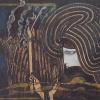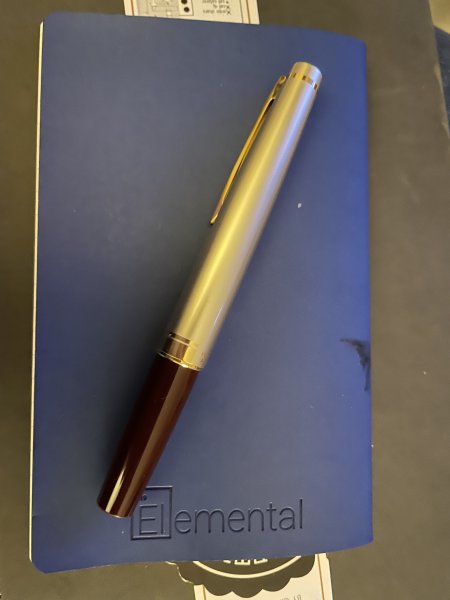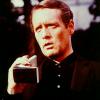Search the Community
Showing results for tags 'pilot elite'.
-

71773856471__B576E343-3DF8-4B10-8BC4-E48645B97978.jpeg
Misfit posted a gallery image in FPN Image Albums
-
Hi everyone, This is a review of the vintage pilot elite (full size). I got it through ebay as NOS and it was pretty cheap since it has a steel gold plated nib and it is made of plastic... And very cheap plastic if you want my opinion... But i was attracted by the look of it and it would complete my collection of elite since I already own the small (Big cap) one. The look : It is actually the best part of this pen in my opinion. It is very subjective of course, everybody won't agree on that but I think it is a very nice pen, black and gold, pretty sharp edges but still a little bit rounded. The golden ELITE word under the cap. Very cool, very stylish, wont go unnoticed ! The nib : I got my Elite with a fine nib ( japanese ) wich would be considered as Extra fine. The nib is nice, gold plated stainless steel but It is very scratchy... It is more than just "feedback" from a very fine nib. So this pen is not my favorite for its writing, I don't use it on a daily basis because of that. The feed : Nothing to say about that... Just good, good ink flow, not too wet not too dry : very reliable, starts up every time and keep going through the pages. Weight and balance : It is a very light pen... it weights about 14g with the converter and ink but it is well balanced, pleasant and comfortable to write with. If you like lighter pens you will appreciate it. Conclusion : It is a good, reliable pen... but it is not very exciting to write with it, the scratchiness of the nib is quite a big issue. I would recommend this pen for a "collector" looking for those types of pen but not as a daily writer.. unless you like very fine and scratchy nibs Despite all this, it is a interesting pen that I got through ebay for very litte money, I still think it is a good buy ! *** English is not my first language so please understand if I made some mistakes ! Your comments are very welcomed !
-
Korean Pilot Elite Questions
the_penfather posted a topic in China, Korea and Others (Far East, Asia)
I got a Pilot Elite that I believe to be from the 1970's/early 80's. This pen appears to be from the Korean Manufacturer with the hooded gold plated steel nib. It is EF but I have a few questions about the pen if anyone knows anything... 1. Japanese Pilots could be dated by the nib - is there a way to date this Korean Version? 2. The Converter inside does NOT want to come out and I do not want to force it if it is not supposed to come out - Is there a trick here? Is this pen a single piece? What am I looking at here? 3. Are there certain inks that I would not want to put into a pen like this - considering that it uses an aeromatic style converter - I believe this is the Con-20 but I'm not sure and am curious about a more current and diff style of converter.- 1 reply
-
- pilot elite
- korean pilot
-
(and 3 more)
Tagged with:
-

Pocket Carry Bring-Everywhere Use-Anywhere Pen: Pilot Elite 95S, Decimo, Or Other?
KLscribbler posted a topic in Fountain & Dip Pens - First Stop
So, I was just thinking over the state of my EDC pen flock, and noted that the one niche in my daily routine not yet filled by a fountain pen is a true pocket carry pen. My previous pen for this purpose, one of those Zebra compact telescopic ballpoints, has just been demoted from pocket carry status because its cap-top jewel had an annoying tendency to work itself loose once every couple of days, causing the jewel, the pen clip, and a washer under the cap jewel to fall off - into my pocket if I'm lucky, or more often, strewn on the sidewalk leaving me to retrace my steps for a good number of minutes. Hence, I'm now looking for a fountain pen that would be good as a pocket carry. First, let me describe the manner in which I usually use my pocket pens: > Manner of carry: clipped to shirt pocket (less often, as many of my shirts don't have pockets), or trouser pocket (more often), or a side pocket in my cell phone pouch (very often), or a small side pocket in my tablet computer pouch (also very often). The pen I pick as a pocket pen cannot be too thick, as the side pockets in my mobile phone and tablet pouches, in particular, are quite slim. (A TWSBI Mini is already too thick, for instance.) > Manner of use: mostly on-the-go jotting. This includes things like jotting down grocery and to-do lists while on the bus/subway, writing down random thoughts in my pocket notebook, the occasional journal writing outdoors when I carry just my journal and a pocket pen, and signing of documents and receipts when I have forgotten to bring my bag/pen case with me. > Other notes: I am mostly a bottled ink guy and do not much like cartridges, so I would not like a pen that is cartridge-only, although ability to use cartridges when needed is good, as I occasionally go on trips where it would not be convenient to bring a vial of ink, so I (grudgingly...) resort to cartridges. With these considerations in mind, I looked around and thought the Pilot Elite 95s, or the similar vintage Pilot Elite models, seemed a good fit for this use case. However, I also thought I should give some consideration to the Pilot Decimo, since many have recommended that pen as a pocket carry/utility/on-the-go pen as well. (The standard VP is too thick, so out of consideration.) To my mind, the pros and cons of each are as follows-- Elite 95s Pros: - Compact and slim, will fit into all of the locations I normally carry my pocket pens. - When posted, seems likely to be more comfortable for longer writing sessions due to its shape. Not that I expect to use my pocket pen frequently for long writing sessions, but when I journal outdoors, that is a consideration. - Many commentators have noted that the nib on this pen is very nice to write with. Cons: - Doesn't have the click-to-write convenience of the Decimo, one-handed use may be less convenient - Looks like it may not be as tough/durable as the Decimo? But that is only speculation based on how it looks... - Might be a little too pretty and eye-catching, not necessarily a good thing when used in places like on a bus or subway. - Not sure how durable the clip is- I have seen one review on Goulet Pens where someone said the clip broke off after a few days of use (!) Decimo Pros: - Click-to-write convenience, especially good when used one-handed - May be tougher and more durable than the Elite? But this is just speculation... - Clip looks stronger and more durable (also just speculation...) - Seems less likely to attract unwanted attention Cons: - Much longer than my usual pocket pens, would require significant changes in my usage and carrying habits (a major con, in my view.) - Fear of accidentally depressing the button and extending the nib - many have commented that this almost never happens in practice, but since I do carry my pocket pens in my trouser pockets, this fear still exists. - Less comfortable for long writing sessions. The clip position and design only bothers me a bit- I have an almost-standard tripod grip, but my thumb is typically placed slightly higher than my index finger, enough that it often rests on the side of the clip. Not enough to be a major turn-off, but it does start to annoy me a bit after writing for, say, more than ten minutes in one sitting. So what do you folks think? Any suggestions or comments on this? Or any other pens you think I should consider as well? (And before anyone mentions it- the Kaweco Sport series is not in my consideration because they are too thick, and the Liliput is also not in consideration because it is cartridge-only. Same goes for the vintage Sailor and Platinum pocket pens, the converters for which are no longer available.) Thanks in advance for your comments and thoughts.- 15 replies
-
- pocket carry
- edc
-
(and 3 more)
Tagged with:
-
I really like the size of this pen, however the medium nib is a bit thick for me so I would like to get another in a finer nib size. I'm having a very hard time finding another elite model this size, whenever I search "pilot elite" in ebay all that pops up are the pocket(?) pen versions. The original listing that I bought it from just called it a "Pilot Elite 14K-585" so looking there isn't much help . Any ideas would be super helpful !
-
Hello there, how does the grip section of the Pilot Elite 95 compare to that of the Pilot M90 and the vintage Pilot Elite's sold by Speerbob? Thanks for your help! Luis
-
Introduction Here’s my first Japanese ‘pocket pen’, or ‘long-short’ pen. It’s a 1976 Pilot Elite, in a half-crosshatch finish I’ve sometimes seen christened the ‘Isaac Newton’. We’ve been acquainted for about 4 months now. http://i773.photobucket.com/albums/yy19/flounder2009/Pilot%20Elite%20Isaac%20Newton/Pilot%20Elite%20A6.jpg Pocket pens are one area where the big Japanese manufacturers really allowed themselves to get inventive with their designs, and create something authentically Japanese rather than a Japanese reflection of Western pens. When I realised that a quality vintage pocket pen could be obtained by bypassing eBay, I became very enthused by the idea of picking up something representative of the genre! If you’re as unfamiliar with the type as I, Bruno Taut’s resource at Crónicas Estilográficas is a mine of fascinating information and photographs of Japanese pocket pens (don’t get lost following all the amazing posts, come back and finish the review sometime!). Appearance & Design The aesthetic of this particular Pilot Elite is decidedly masculine, but in a classy, stylish way more self-possessed than that of the all-metal, exposed bolts (even bolt action) me-macho cottage industry pens currently in vogue. ‘Debonair ‘ is probably the word I’m looking for, because this is one of very few inanimate objects I think of as having bone fide charm. Looking down at the enamelled steel crosshatch design of its unusually long cap over a short black barrel, it’s easy to anthropomorphise the Elite as a dapper gent in a windowpane-patterned coat. http://i773.photobucket.com/albums/yy19/flounder2009/Pilot%20Elite%20Isaac%20Newton/Pilot%20Elite%20overview.jpg During my browse of pens available, I found it curious how few masculine or even gender-neutral designs seem to be around. In contrast, there’s a very good selection of overtly feminine Japanese pocket pens! To my uncouth eye at least, their colours, finishes, fat swoopy faux cap bands and floral decorations are quite reminiscent of lipsticks. This is not a criticism, only rather a surprise, given their origin story as pens to fit in the shirt pocket of conservative 1960’s Japanese salary men. Is there a missing chapter? Anyway, back to the appearance of this specific Pilot Elite. The rhodiated 18 karat gold nib understates the pen’s worth, and complements the Elite’s unaffected chrome plated clip & section ring well. In a world where so many steel nibs are emblazoned with decorative tildes and gold plated to affect costliness, I appreciate that Pilot had the daring not to flaunt where the money’s been spent! The semi-hooded nib design sported by this Elite arguably strikes the best balance between appearance and practicality. This Elite differs from others of the same name that are fitted with the ‘inset’ nib type. Here, the tab-clamped nib is semi hooded for practicality. There are no sealant-reliant joints through which ink can wick to your fingers (I had enough of tending to that kind of quirk with my Targas). Reading through the experiences of Hari et al. (1,2,3) prior to purchase, I figured I’d be happier in avoiding the inset nib Elites, sidestepping any future hassles. For similar reasons, I decided against another Pilot pocket pen I was considering, the conventially-nibbed Volex. The Volex has metal trim rings abutting the nib; while these look purposeful, too many examples had suffered corrosion owing to ink exposure. The overall look and certain design elements are reminiscent of the Parker 65; in particular, the vestigial hood and clip on nib. Both are improved upon in ways that make me think the Elite’s designers cast an eye over Parker’s 1967 effort; the hood plastic is much thicker, shorter, and shaped in a less fragile wave rather than an acute point. The nib geometry is far less complex compared to the 65’s myriad of folds and curves, and the feed certainly looks easier to nib-set than the 65’s thick wedge of nightmare (the service manual for which warns against separating from the nib)! http://i773.photobucket.com/albums/yy19/flounder2009/Pilot%20Elite%20Isaac%20Newton/Pilot%20Elite%20Parker%2065%20open%20comparison.jpg Inevitably for a pocket pen, a lot of effort has gone into the cap’s functionality. The clip is spring mounted, and the section ring doubles as a stop for the slip cap, after the fashion of Parker’s 45. I like this feature, it means the cap can never be jammed on, or the inner cap split from excess stress. Due to the unusually long section, the cap’s steel clutch fingers engage with the most cylindrical portion of the section through over an inch of travel, making it quite secure by the time it reaches the section ring stop. As well as lending a high quality look, the depth of the cap engraving gives excellent tactile purchase for sliding the slip cap off and on - capping and posting being a strictly two hand exercise. Construction & Quality As a major feature of this pen style’s design, the elongated cap is well made inside and out. In particular, the cap crosshatching and enamelling is really superb – just look at depth of impression the crosshatching makes in a blob of Rodico putty. The rough troughs visible in the macro detail must lend an excellent key to the enamel, none of which shows any sign whatever of chipping away in the last 40 years. http://i773.photobucket.com/albums/yy19/flounder2009/Pilot%20Elite%20Isaac%20Newton/Pilot%20Elite%20cap%20detail.jpg I wish I knew more about how the cap was put together, because it looks a high quality item! Peering inside, there's the inner cap you'd expect, and it's nice to see that the steel cap clutch has 5 fingers, which reduces their individual load and helps keep the cap concentric to the barrel. The bevelled clip is usefully spring mounted, as previously mentioned. This one is in pretty fresh condition - from the listings I've seen, the clip’s plating seems to be this model’s weak spot. The cartridge piercing tube is plastic rather than steel, as with other Pilot cartridge pens I've seen. It also has a split in the middle, which seems to fulfil the same function as the later Pilot 78G’s molded cartridge piercer ink flow channels. Part of me wishes the piercer was made of steel, but I have no basis to denigrate the longevity of Pilot's plastic piercer design. As seems to be common with many Pilot pocket pens, the coupler screwed right out of the section, so I secured it with a thin smear of especially weak rosin sealant. Exterior plastics were tired throughout, with many microscratches. Most polished out, but not quickly or easily. This, together with the fact that I’ve not seen any photos or read any reports of warped vintage pocket pens, hopefully means that strong, high quality plastics were used to manufacture the Elite. Overall, fit and finish are excellent: Little details jump out at you, such as the cap being perfectly concentric to the stop ring, or the split between tines and oblong breather hole being perfectly centred. There is a slight gap between the nib and ‘hood’, but I’m not sure if this is intentional or perhaps has some function – I’ve seen the same in many photos of this pen. Weight & Dimensions As is probably fitting for a pocket pen, it is ideal for concealed carry, being diminutive and light enough not to alter the drape of even the cheapest, flimsiest high summer linen. With the current ink cartridge over halfway spent, the Elite weighs 16 grams, the cap contributing 9. http://i773.photobucket.com/albums/yy19/flounder2009/Pilot%20Elite%20Isaac%20Newton/Pilot%20Elite%20Parker%20Jotter%20closed%20comparison.jpg The Elite really executes the ‘long-short’ format well. Capped, it is shorter (11.8cm) than a standard Parker Jotter ballpoint, and posted, longer (14.8cm). The posted length is excellent, and the semi-hooded design and elongated section will allow a very relaxed, spread-fingered grip. The section thickness is on a par with the Parker 61’s. http://i773.photobucket.com/albums/yy19/flounder2009/Pilot%20Elite%20Isaac%20Newton/Pilot%20Elite%20Parker%20Jotter%20open%20comparison.jpg Unposted, I’ve found the Elite is fine for jotting down a phone number, email address or even a brief note (at the laconic extreme of brevity). For heavy writing sessions, I have noticed that the section can get a little slippery after writing at speed for 1.5 hours in a hot room. Nib & Performance 18 karat gold, rhodium plated. The nib is very appealing! http://i773.photobucket.com/albums/yy19/flounder2009/Pilot%20Elite%20Isaac%20Newton/Pilot%20Elite%20nib%20detail.jpg The shape of the nib gives a strong sense of accuracy, a sort of visual allusion to a long, tapered arrow. In isolation, you can see it’s in fact quite short! The oblong breather hole and slender delta tine sweep help create this clever effect. The continuity of the mildly tapering section and ‘long’ nib give an agreeable sensation of precision control akin to writing with a recently sharpened pencil. The cap encourages a fairly low angle grip, which I prefer anyway. On first receipt, the fine nib was slightly too feedback-y on certain strokes, but responded well to slight micromesh polishing. Aside from that minor inconvenience – to be expected after 40 years of a stranger’s handwriting in a foreign script – the nib had no other issues. The tines were still well aligned, testament to a light hand in previous use. Confounding the usual fountain pen caveats, this Elite has the most remarkable dry out resistance when left uncapped. Using standard Pilot blue cartridges, the pen boasts instant start up on a 90gsm Oxford Campus pad, after 25 minutes left lying uncapped. This is phenomenal, I’ve no idea how Pilot achieved it. For all I know, it could last longer than the 25 minutes I’ve (repeatedly) tested for. The 18k nib is quite soft, and writes an even line of decent wetness using Pilot blue. Being a Japanese fine, it’s versatile, capable of writing a composed line even on cheap, absorptive paper. Filling System & Maintenance The proprietary Pilot cartridges the Elite uses are among my favourites. Their mouths are wider than their ends, and Parker-style channels are molded into the whole length of the walls to ensure ink flows downward rather than beads away from the feed. http://i773.photobucket.com/albums/yy19/flounder2009/Pilot%20Elite%20Isaac%20Newton/Pilot%20Elite%20capilary%20detail.jpg To fit the Elite’s pocket pen profile, the cartridge meets it piercer especially deep within the section. This obscures much of the cartridge, making the ink level difficult to judge. Perhaps in recognition of this drawback, the feed is translucent to help warn when the ink is nearly emptied. http://i773.photobucket.com/albums/yy19/flounder2009/Pilot%20Elite%20Isaac%20Newton/Pilot%20Elite%20carts%20and%20converters.jpg I think it’s commendable this diminutive pen uses standard size carts with no further penalties - I’m assuming there must be a commensurate reduction in the feed’s buffering capacity, but haven’t experienced any flow issues at all. For bottled inks, the Elite will also accept certain converters from Pilot’s range. On the FPN forum, Butangmucat has reported the new con-40 fits his Elite; I’ve picked up a con20 squeeze converter before they’re discontinued. Half the reason I went with a Pilot pocket pen rather than less expensive but very similar looking models by other manufacturers was how impressed I’ve been with the quality of Pilot’s cartridges, ink, and converter availability. To get the pen working again mostly required only a soaking and flushing to remove the majority of dried up old ink, then a short spell in the ultrasonic cleaner. The nib required a little smoothing but not much. Fairly uneventful! http://i773.photobucket.com/albums/yy19/flounder2009/Pilot%20Elite%20Isaac%20Newton/Pilot%20Elite%20servicing.jpg Cost & Value Begad, here comes a strong opinion! Grin and nod along till the ghastly thing blows away to bother someone else! For Western enthusiasts, I’ve noticed that vintage Pilot pocket pens offered on eBay and forums like FPN are dear, at a distasteful markup of 100-200% over the Japanese going rate. This used to be confined to the Pilot Myu, but now the more conventional Elite and even plain steel Volex are being listed – used - at unseemly asking prices up to and comfortably exceeding the price of a brand new Elite 95S. This includes obviously flawed examples with unsecured section-barrel couplers, corroded Volex nib rings, and dried up old carts still installed, indicative of neglect. I ask you, is that playing the game? Eschewing the robber barons, I paid slightly less than I usually would for an unrestored domestic Parker 51 (including shipping charges etc.). In the condition my Elite turned up in, and having the tools & supplies to hand to service the pen, I think it was very good value; I’ve no buyer remorse. Had I paid twice as much, or had it suffered damage in the simple bubblewrap envelope it was transported in, my ability to appreciate its many charms would be a little more tempered. Conclusion I realise a lot of this review reads like a mash note! Well, there you have it; I’m very taken with the Pilot Elite. Certainly, there’s plenty that can go wrong with you’ve no knowledge about the model you’re interested in, when you remove eBay buyer protection from the equation, and when you add useless machine translation to cross-planet shipping. In this happy case, Tyche nodded her approval and the whole show ran without a hitch. This is a great fountain pen! http://i773.photobucket.com/albums/yy19/flounder2009/Pilot%20Elite%20Isaac%20Newton/Pilot%20Elite%20pangrams.jpg Ps – Archaeology buffs, for a slice of living morphological typology, compare the form and function of this 40 year old Elite with the appropriately named Pilot Timeline range of today!
- 16 replies
-
- isaac newton
- 1976
-
(and 3 more)
Tagged with:
-
I recently picked up my first pocket pen, a rather smashing Pilot Elite! The nib is marked H1276, which the excellent blog Crónicas Estilográficas tells me means Hiratsuka factory, December of 1976. The barrel code says "QB 08". Does that mean the pen body was made in the same factory in 1977, February 8th, or am I reading the guide incorrectly? http://i773.photobucket.com/albums/yy19/flounder2009/Pilot%20Elite%20Isaac%20Newton/Pilot%20Elite%20Isaac%20Newton%20barrel%20codes.jpg












